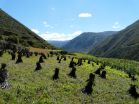(Press-News.org) CHICAGO -- Genetic testing of Iñupiat people currently living in Alaska's North Slope is helping Northwestern University scientists fill in the blanks on questions about the migration patterns and ancestral pool of the people who populated the North American Arctic over the last 5,000 years.
"This is the first evidence that genetically ties all of the Iñupiat and Inuit populations from Alaska, Canada and Greenland back to the Alaskan North Slope," said Northwestern's M. Geoffrey Hayes, senior author of the new study to be published April 29, 2015, in the American Journal of Physical Anthropology.
In this study, all mitochondrial DNA haplogroups previously found in the ancient remains of Neo- and Paleo-Eskimos and living Inuit peoples from across the North American Arctic were found within the people living in North Slope villages.
These findings support the archaeological model that the "peopling of the eastern Arctic" began in the North Slope, in an eastward migration from Alaska to Greenland. It also provides new evidence to support the hypothesis that there were two major migrations to the east from the North Slope at two different times in history.
"There has never been a clear biological link found in the DNA of the Paleo-Eskimos, the first people to spread from Alaska into the eastern North American arctic, and the DNA of Neo-Eskimos, a more technologically sophisticated group that later spread very quickly from Alaska and the Bering Strait region to Greenland and seemed to replace the Paleo-Eskimo," Hayes said.
"Our study suggests that the Alaskan North Slope serves as the homeland for both of those groups, during two different migrations. We found DNA haplogroups of both ancient Paleo-Eskimos and Neo-Eskimos in Iñupiat people living in the North Slope today."
Hayes is an assistant professor of endocrinology at Northwestern University Feinberg School of Medicine and an assistant professor of anthropology at Northwestern's Weinberg College of Arts and Sciences. He has been studying population genetics of the Arctic for more than a decade.
At the request of Iñupiat elders from Barrow, Alaska, who are interested in using scientific methods to learn more about the history of their people, Hayes and a team of scientists extracted DNA from saliva samples given by 151 volunteers living in eight different North Slope communities. This is the first genetic study of modern-day Iñupiat people.
For this paper, the scientists sequenced and analyzed only mitochondrial DNA. Mitochondrial DNA is passed down from mother to child, with few changes from generation to generation.
Ninety-eight percent of the maternal linages in this group were of Arctic descent. The scientists found all known Arctic-specific haplogroups present in these North Slope communities. The haplogroups are: A2a, A2b, D4b1a and D2.
D2 is the known haplogroup of ancient Paleo-Eskimos. Until this study D2 had only been found in the remains of ancient Paleo-Eskimos.
D4b1a is a known haplogroup of the ancient Neo-Eskimos, the much more technologically sophisticated group that came after the Paleo-Eskimos and seemed to replace them and populate a large part of the Arctic in a short amount of time.
"We think the presence of these two haplotypes in villages of the North Slope means that the Paleo-Eskimos and the Neo-Eskimos were both ancestors of the contemporary Iñupiat people," said Jennifer A. Raff, first author of the study and a post-doctoral fellow in Hayes' lab at the Feinberg School when the research was being done. "We will be exploring these connections in the future with additional genetic markers."
Another haplogroup that surfaced in this study was C4. This is typically only seen in Native Americans much farther south. Its geographic distribution suggests that it might have been one of the haplogroups carried by the earliest peoples to enter the Americas. The researchers think it could be seen in the North Slope because of recent marriages between Athapascan and Iñupiat families or because it is a remnant of a much more ancient contact between these groups.
One more surprise in this study was evidence there may have been some migrations of Greenlandic Inuit back to the Alaska North Slope. The scientists plan to explore this in the future with additional genetic markers, too.
This work is part of the Genetics of the Alaskan North Slope project, funded by a grant from the National Science Foundation's Office of Polar Programs. The goal of the project is to reconstruct the human genetic history along the North Slope. The scientists hope the project will be a model for research partnerships between geneticists and indigenous peoples.
While this study revealed exciting new evidence about the history and prehistory of Iñupiat women, it also confirms local history about the close-knit ties of the North Slope villages.
"We found that there were many lineages shared between villages along the coast, suggesting that women traveled frequently between these communities," Hayes said. "In fact, when we compared the genetic composition of all the communities in the North Slope, we found that they were all so closely related that they could be considered one single population. This fits well with what the elders and other community members have told us about Iñupiat history."
Future work will analyze genetic markers on the Y-chromosomes from men in the North Slope, taking a closer look at the population history of men, as well as how contact with outsiders in the 19th century affected the Iñupiat peoples.
INFORMATION:
Additional authors of this study are Margarita Rzhetskaya of Northwestern and Justin Tackney of the University of Utah. The National Science Foundation's Office of Polar Programs funded the study (grant numbers OPP-0732846 and OPP-0732857).
NORTHWESTERN NEWS: http://www.northwestern.edu/newscenter/
PULLMAN, Wash.--Climate change may be responsible for the abrupt collapse of civilization on the fringes of the Tibetan Plateau around 2000 B.C.
WSU archaeologist Jade D'Alpoim Guedes and an international team of researchers found that cooling global temperatures at the end of the Holocene Climatic Optimum, a 4,000 year period of warm weather, would have made it impossible for ancient people on the Tibetan Plateau to cultivate millet, their primary food source.
Guedes' team's research recently was published online in the Proceedings of the National Academy of Sciences. ...
A vaccine containing a protein necessary for virus replication can boost an HIV-infected patient's immune system, according to clinical research published in the open access journal Retrovirology. This boost can result in increased effectiveness of antiretroviral drugs.
When people are first diagnosed with HIV they are put on antiretroviral drugs, also known as highly active antiretroviral therapy (HAART). These drugs can stop the virus reproducing almost completely. When taking HAART, however, it is known that the virus can still replicate at low levels and accumulate ...
For patients in the early stage of non-small cell lung cancer, surgical resection yields optimal outcomes. Prior investigations have shown that different resection procedures have very different outcomes, with pneumonectomy associated with three-fold higher mortality than other resection types. While it is understandable that pathological and physiological factors influence a surgeon's choice of surgery for a particular patient, the results presented in this study suggest that physician discomfort with the operative complexities of a procedure may lead to selection of a ...
Hospital readmission rates after major thoracic surgery can run as high as 10-17%. Alarmingly, readmission after pulmonary resection for lung cancer has been associated with worse outcomes, including higher mortality. Thus, reducing readmissions after thoracic surgery can both save lives and reduce healthcare costs. Studies in internal medicine and cardiology have shown that programs that improve the transition from hospital to post-discharge care can be effective in decreasing emergency room visits and re-hospitalization. This study from McMaster University describes for ...
People suffering from the common lung disease, chronic obstructive pulmonary disease (COPD), have an increased risk of sudden cardiac death (SCD), according to new research published online today (Wednesday) in the European Heart Journal [1].
When compared with people of the same age and sex who do not have the disease, those with COPD have a 34% increased risk of SCD overall, but their risk almost doubles more than five years after first being diagnosed with COPD. In COPD patients who have frequent exacerbations (sudden worsening of their symptoms, such as shortness ...
Marine ecosystems can be changed by night-time artificial lighting according to new research published in the Royal Society journal Biology Letters. The results indicate that light pollution from coastal communities, shipping and offshore infrastructure could be changing the composition of marine invertebrate communities.
Researchers from the Universities of Exeter and Bangor used a raft in the Menai Strait to monitor how artificial light at night affects the settlement of marine invertebrates into new habitats. Light is an important cue which guides the larvae of marine ...
New research by scientists at New Zealand's University of Otago suggests a need for a fundamental rethink of the evolutionary path of enzymes, the proteins vital to all life on Earth.
Enzymes catalyse a vast array of biologically relevant chemical reactions even in the simplest living cells.
Biochemist Dr Wayne Patrick says that people tend to imagine evolution as a slow and steady march from barely functional life forms in the primordial soup, towards a modern-day pinnacle of near perfection.
"When it comes to enzyme evolution, this is also the textbook version ...
MORE than two-thirds (69 per cent) of bowel cancer patients say they weren't advised to exercise regularly after their diagnosis - despite evidence that brisk physical activity is linked to better survival in bowel cancer, according to a Cancer Research UK study published today (Wednesday) in BMJ Open.
The research, from the Cancer Research UK Health Behaviour Research Centre at UCL (University College London), is the largest study of its kind. More than 15,000 bowel cancer patients* were asked about their current level of physical activity and whether they were advised ...
The coalition government derailed a successful programme that reduced salt content added to foods by industry, argue experts in The BMJ this week.
A poor diet is the leading cause of death and disability in the UK and worldwide. Large amounts of salt, for example, are added to food by industry and eating too much can raise blood pressure, a major factor associated with strokes, heart failure and heart attacks.
The UK's Food Standards Agency (FSA), established in 2000, became a "world leader" in improving nutrition and pioneered a salt reduction programme by working ...
Calorie counts should be mandatory on all alcoholic drinks as a matter of urgency, argues a leading public health doctor in The BMJ this week.
Fiona Sim, Chair of the Royal Society for Public Health, says alcoholic drinks contribute to obesity and the law "should require restaurant menus and labels to make energy content explicit in addition to alcohol content."
She explains that, since 2011, packaged foods in the European Union have been subject to regulation requiring labelling with their ingredients and nutritional information, including energy content (calories). ...

